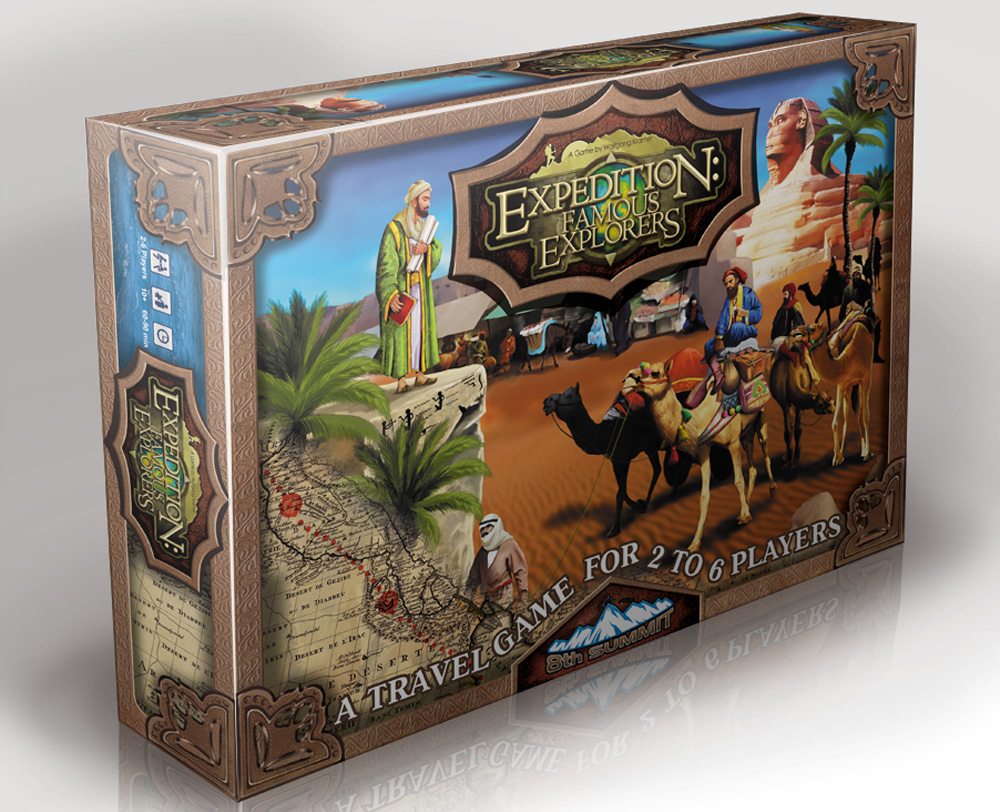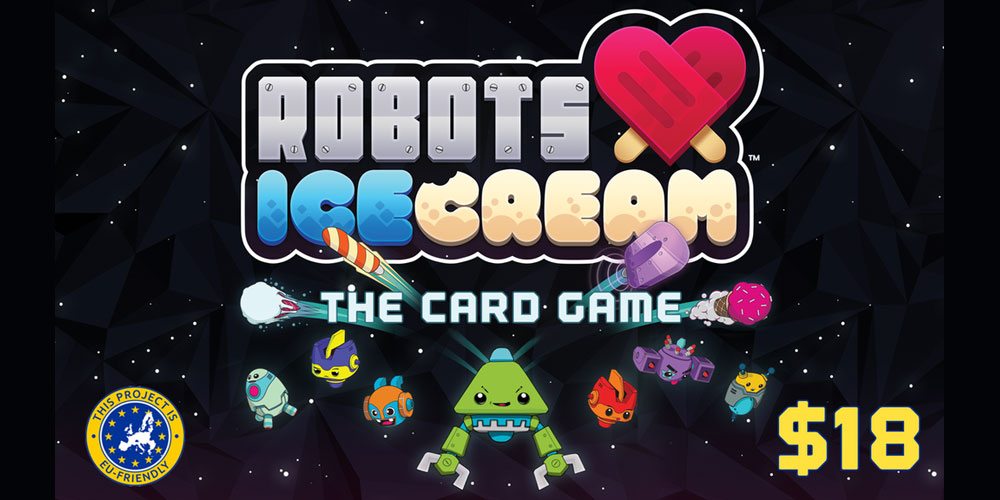It’s a big world, with lots of places to visit, people to meet, sights to see. In Expedition: Famous Explorers, you and other players direct the routes of three expeditions, trying to guide them to the locations that are important to you. Expedition: Famous Explorers is a new version of one of Wolfgang Kramer’s earlier designs, Wildlife Adventure.
At a glance: Expedition: Famous Explorers is for 2 to 6 players, ages 10 and up, and takes 60-90 minutes to play. It retails for $49.99, and was published by 8th Summit after a successful Kickstarter campaign in March 2013. The game works fine with kids, and has a strong educational component (though you can play the game without really learning anything, if that’s your style).

Components:
- 1 game board
- 135 plastic arrows (45 each in three colors)
- 30 Ticket tokens
- 36 Destination tokens (6 each in 6 colors)
- First Player token
- 6 wooden score tokens
- 79 Expedition cards
- 7 Explorer cards
- 10 Event cards
The game board is fairly large and sturdy—most of it is a map of the world with locations and paths marked, and there’s a scoring track along the bottom. The locations are grouped roughly by continent, with each region color-coded. Each spot is represented by a dot on the map, and next to each dot is a name and a larger circle (also color-coded) with an image in it. Dotted lines form paths between the dots. The images are a mix of photography and illustrations, color and black-and-white, which makes the board very busy visually and a little hard to read at times.

The Expedition cards have a similar issue: each card has a name of either a location or an explorer, accompanied by a section of text about that place or person. The cards are color-coded to match the regions (though I’ve spotted one or two that were incorrectly colored). A few of the cards (see the Caspian Sea above) have a blue circle with a red X in one corner—that simply means it’s within two spaces of the Start space, and is ineligible to be an important destination for the players. It would have been nice to have an inset map or something to help locate places on the board—essentially on this entire card only the title and color (and potentially the red X) are game-relevant information.
The destination tokens and ticket tokens are cardboard punch-out pieces and are fine. The destination tokens are round and colored in the various player colors, and fit inside the location circles on the board. The tickets are small rectangular tokens.
The arrows are made of plastic, and fit along the various paths on the board. While I found one or two slightly bent arrows, for the most part these were fine. The bright red, yellow, and blue are easily visible against the board, which is nice.

How to play
The object of the game is to score the most points by reaching your personal destinations as well as public destinations.
At the beginning of the game, each player is dealt a number of Expedition cards (depending on number of players), and six Expedition cards are dealt face-up as public destinations. For the initial setup, any public destination with a red X is replaced and reshuffled into the deck. Players also receive all the destination tokens of their color and three ticket tokens. Scoring tokens go on the 0 space of the score track. The Event and Explorer cards are only used in the advanced variant.
After everyone has looked at their cards, players take turns placing destination tokens on the board, choosing from the Expedition cards in their hands. Again, you may not pick cards that are marked with the red X. Each player marks four locations. (The other two tokens are only used in the advanced game and may be put back in the box.) These marked locations are important destinations, and are worth more points.
All three expeditions begin in Scandinavia at the Start space, one marked by each color of arrows. On your turn, you place an arrow to extend the expedition of your choice. If you land on a green arrow, you may immediately place another arrow of any color. If you land on a red arrow, you receive a ticket from the supply.
On your turn, you may also play up to two tickets. Each ticket may be used for one of the following effects:
- Play an extra arrow of any color.
- Remove the last arrow of any color.
- Discard an Expedition card, then draw two new cards and keep one.
If you complete a loop, you also get an extra arrow extending anywhere off that loop, but only one loop per turn. Arrows of different colors may run next to each other on the same path, but you may never have two arrows of the same color on the same path.
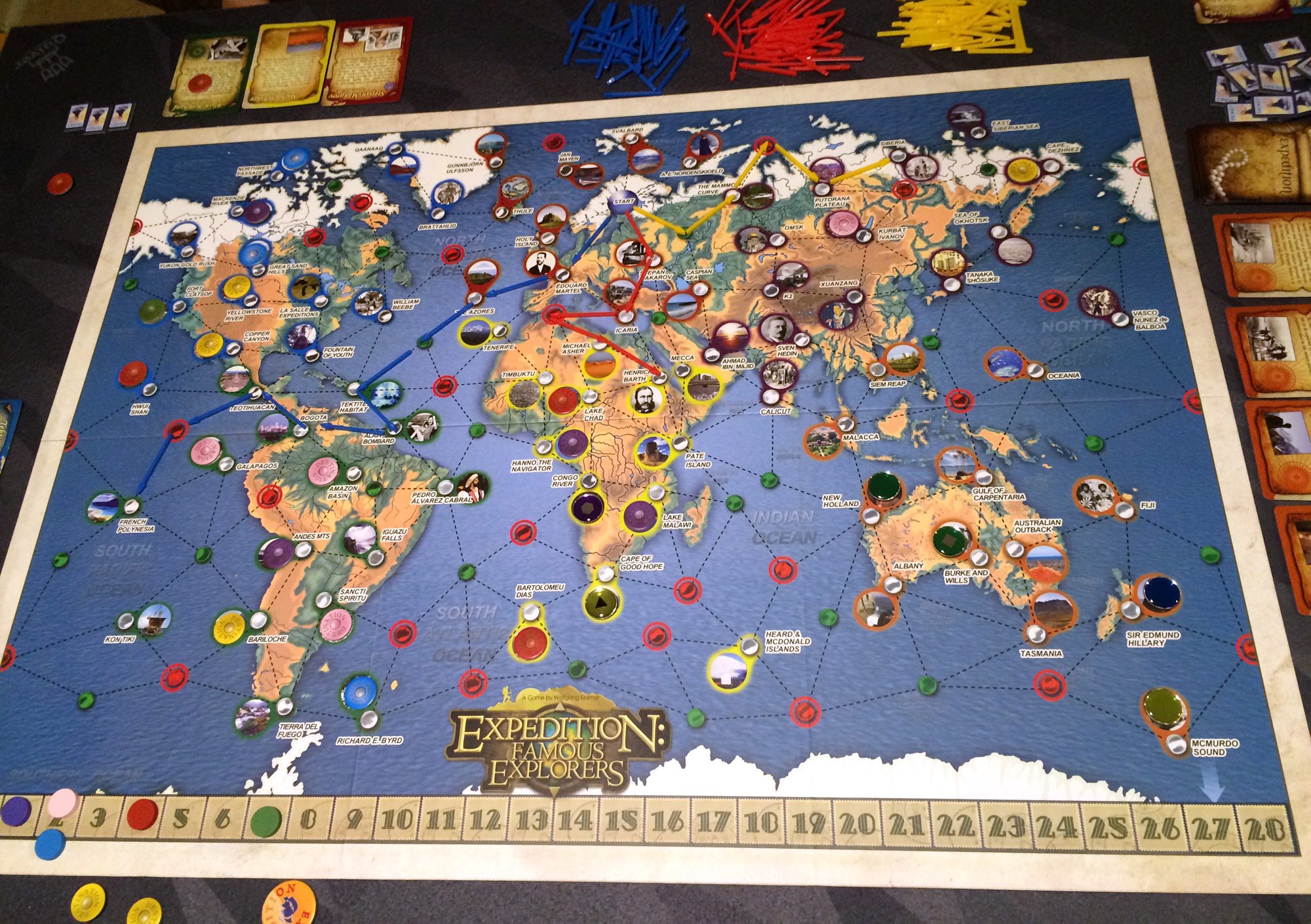
Any time an expedition goes through a location that matches a card in your hand, you get a point and put the card down on the table. If an expedition goes through one of your important destinations, you remove the destination token from the board and score a point for the card and an additional point for the token. Finally, if you place an arrow that sends an expedition to one of the public destinations, you claim that card and get a point, and then replace the card with one from the deck.
The game ends either when all the arrows run out, or (more likely) when any player reaches all of the destinations in her hand. Each player loses 1 point per card left in hand, and 1 point for each destination token left on the board. Highest score wins.
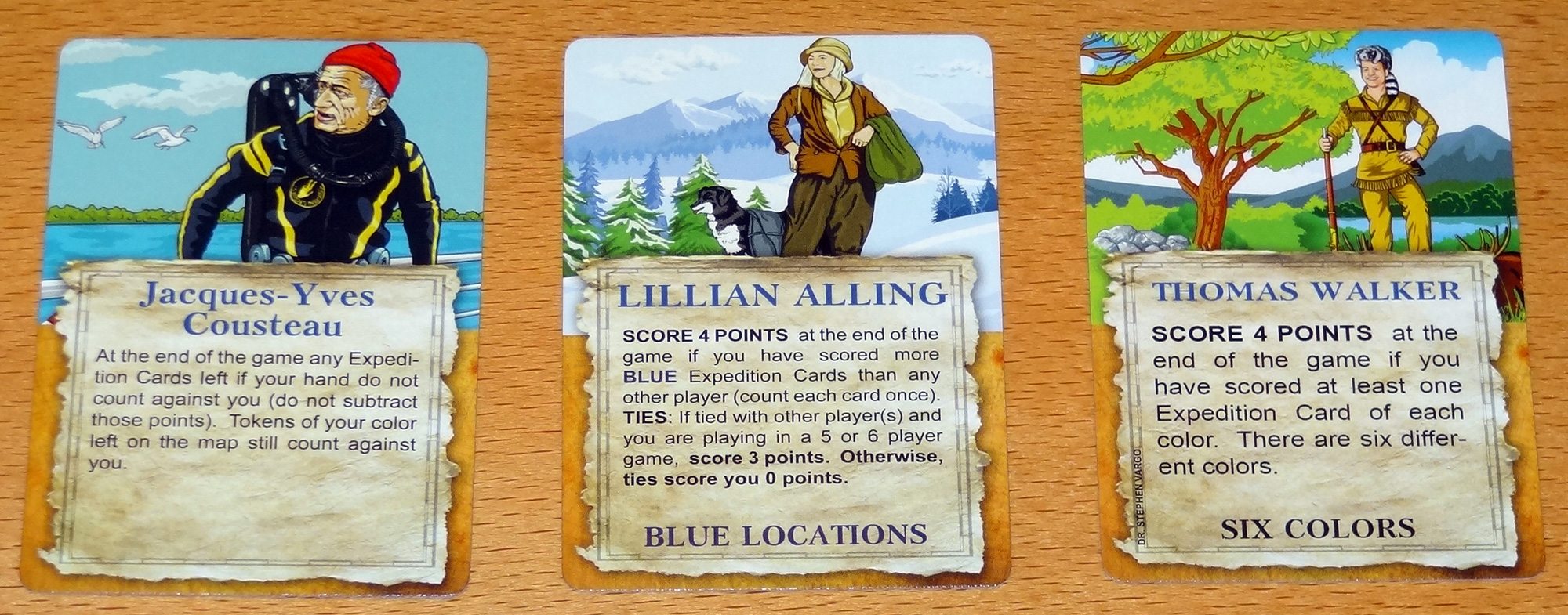
In the advanced variant, there are six Explorer cards turned face up during set up, plus two face-down Secret Destinations. Explorers may be purchased for two tickets each, and are replaced by Event cards, which may be purchased for 1 ticket each. Most Explorers award bonus points for having the most of a particular color location, though Jacques Cousteau keeps cards in your hand from counting against you and Thomas Walker scores bonuses if you score at least one card from each region.
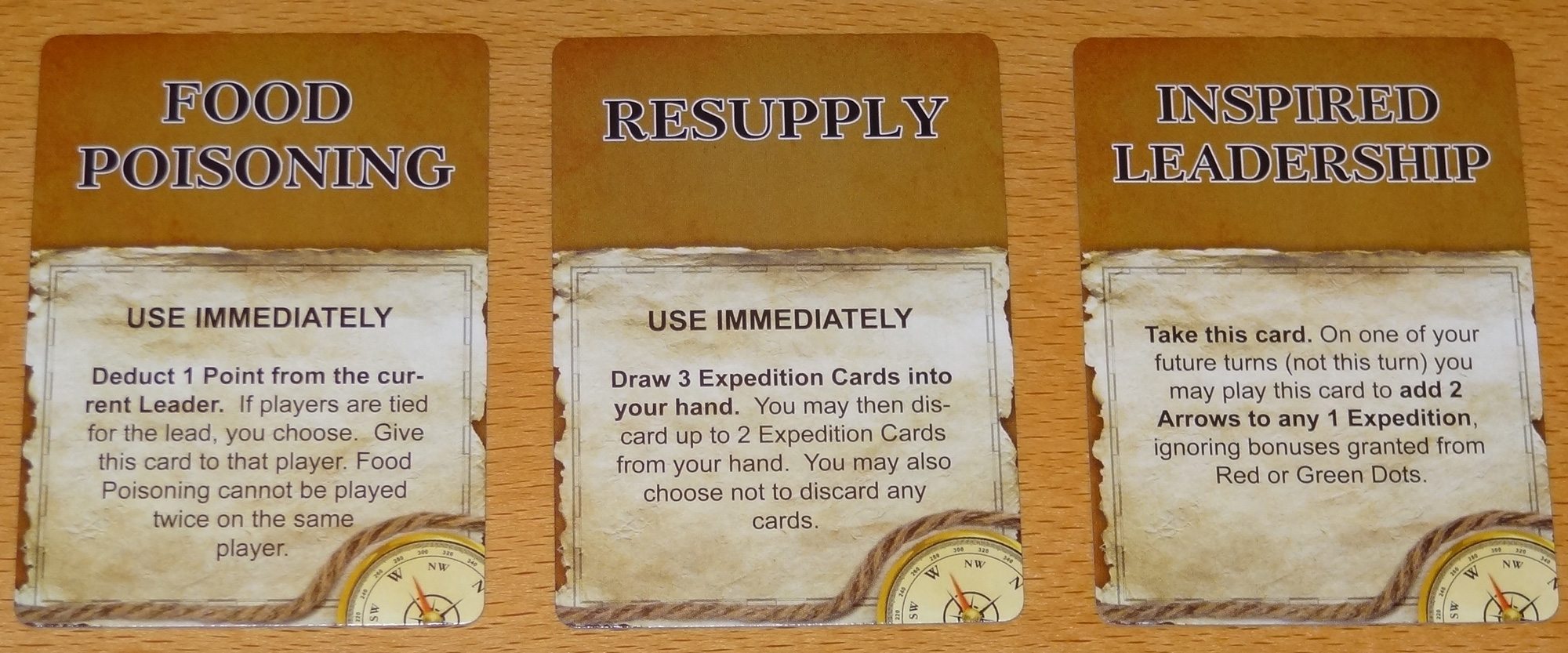
Some Event cards must be used immediately, and some can be held and be played on future turns.
For the secret destinations, you may peek at one if you land on a green dot on the board. Instead of placing a new arrow, you may peek at one of the secret locations and mark it with one of your extra destination tokens, indicating that you’ve seen it and may peek at it at any time. To claim a secret destination, you must lead an expedition to that location and flip the card during that turn—you score two points, and then replace the secret destination with a new one.
The Verdict
When I first played Expedition: Famous Explorers, I didn’t realize it was a reimplementation of an older game, but it felt like an older design, in a good way. The rules were pretty easy to explain, and it had a healthy dose of competition without being too cutthroat. Designer Wolfgang Kramer has a huge list of games to his name and has won the Spiel des Jahres several times, and this one is a nice title that I think could work with a broad audience.

I love when you can look at the table at the end of the game and see a big picture—tile-laying games like Carcassonne form a big map at the end, for example. Expedition: Famous Explorers is fun because you can look at the three expedition routes at the end to see where they went. In the photo above, you can see that three paths never intersect, though the red and blue paths come close in some places.
The gameplay is easy to explain—add an arrow, spend up to 2 tickets to do extra things. Try to hit your destinations, or convince other players to reach them for you. Even the advanced rules aren’t too complex, and for experienced gamers could be included the first time you play.
When we played, there was a lot of back-seat driving going on: “You know, a better route to get to your destination is through the Azores. Really.” And sometimes direct negotiation: “Okay, look, I really want you to go through the Azores. If you do, I’ll take this route over here that’ll get you closer to Oceana.” The fact that all of you are driving all three expeditions means that there is a lot of player interaction—you definitely have a stake in what other players are doing on their turns, and this is fantastic.
It’s also fun that you know some of the other players’ destinations. Each player has between 9 and 12 cards, but you know where 4 of them are because they’re marked. So it’s a little bit of information you can use in your negotiations. Of course, you don’t know if their other locations are nearby or on a completely different continent.
The one thing that wasn’t great, in my opinion, is the appearance. The quality of the components is fine, but everything looks jumbled together. The cards could have included a little more information that is actually pertinent to gameplay and still retained the educational value. If you look up photos of older editions, the board actually looks cleaner and easier to read.
Because of the difficulty of spotting locations, we found it was helpful to mark the public locations on the board with some tokens. We used a spare set when we had fewer than 6 players, or some of my Penny Gems when we had 6 players. I found it a helpful way to visualize where things were on the board rather than having to keep looking over at the six public destination cards.
There is an educational component to the game: all of the expedition cards tell you about the locations or explorers, and even if you don’t read the card at all, you’ll at least learn one piece of information by finding the spot on the map. I think in the future when I play this with just my kids, I’ll probably stop and read some more of the cards as they’re reached, particularly the names and places that are unfamiliar. But I think it would serve better as a launching point for more research rather than a lesson in itself.
Overall, I like Expedition: Famous Explorers and I’m looking forward to playing again. It was a good reminder for this cult-of-the-new gamer that there are still great experiences to be had in older designs. I’m glad this title gets a new life and I hope a lot of people discover it for themselves. My only wish is that it had better graphic design.
Expedition: Famous Explorers is available from Amazon, or check with your local game store.
Disclosure: GeekDad received a review copy of this game.

